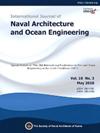Wing shape optimization for an air-launched underwater glider considering impact loads and gliding performance
IF 3.9
3区 工程技术
Q2 ENGINEERING, MARINE
International Journal of Naval Architecture and Ocean Engineering
Pub Date : 2025-01-01
DOI:10.1016/j.ijnaoe.2025.100683
引用次数: 0
Abstract
The air-launched underwater glider has two typical scenarios that need to be specially considered in its design: the water impact stage after air-launched deployment and the gliding stage of the glider in the water. The wing shape of the underwater glider has a significant impact on the hydrodynamic performance in both scenarios. This study proposes a multi-objective optimization method for the wing shape optimization of air-launched gliders, comprehensively considering the gliding motion performance and impact load performance during water entry. An Artificial Neural Network (ANN) and Polynomial Response Surface (PRS) method were used to establish surrogate models for the gliding motion and impact load, respectively, and the accuracy of these surrogate models was verified. The sensitivities of the different design variables to the output parameters were analyzed. An optimized wing shape can improve the gliding range and reduce the impact load. Considering the uncertainties in the net buoyancy and energy consumption in practical applications, an interval optimization algorithm for wing shape optimization was proposed. The interval optimization results provided a more reasonable wing-shape design scheme.
考虑冲击载荷和滑翔性能的空射水下滑翔机翼形优化
空射式水下滑翔机在设计时需要特别考虑两种典型场景:空射展开后的水冲击阶段和滑翔机在水中的滑行阶段。在这两种情况下,水下滑翔机的翼形对其水动力性能都有显著影响。本文提出了一种综合考虑滑翔运动性能和入水冲击载荷性能的多目标翼形优化方法。采用人工神经网络(ANN)和多项式响应面(PRS)方法分别建立了滑翔运动和冲击载荷的代理模型,并验证了代理模型的准确性。分析了不同设计变量对输出参数的敏感性。优化后的翼型可以提高滑翔距离,减小冲击载荷。考虑到实际应用中净浮力和能耗的不确定性,提出了一种用于机翼外形优化的区间优化算法。区间优化结果提供了更为合理的翼型设计方案。
本文章由计算机程序翻译,如有差异,请以英文原文为准。
求助全文
约1分钟内获得全文
求助全文
来源期刊

International Journal of Naval Architecture and Ocean Engineering
ENGINEERING, MARINE-
CiteScore
4.90
自引率
4.50%
发文量
62
审稿时长
12 months
期刊介绍:
International Journal of Naval Architecture and Ocean Engineering provides a forum for engineers and scientists from a wide range of disciplines to present and discuss various phenomena in the utilization and preservation of ocean environment. Without being limited by the traditional categorization, it is encouraged to present advanced technology development and scientific research, as long as they are aimed for more and better human engagement with ocean environment. Topics include, but not limited to: marine hydrodynamics; structural mechanics; marine propulsion system; design methodology & practice; production technology; system dynamics & control; marine equipment technology; materials science; underwater acoustics; ocean remote sensing; and information technology related to ship and marine systems; ocean energy systems; marine environmental engineering; maritime safety engineering; polar & arctic engineering; coastal & port engineering; subsea engineering; and specialized watercraft engineering.
 求助内容:
求助内容: 应助结果提醒方式:
应助结果提醒方式:


